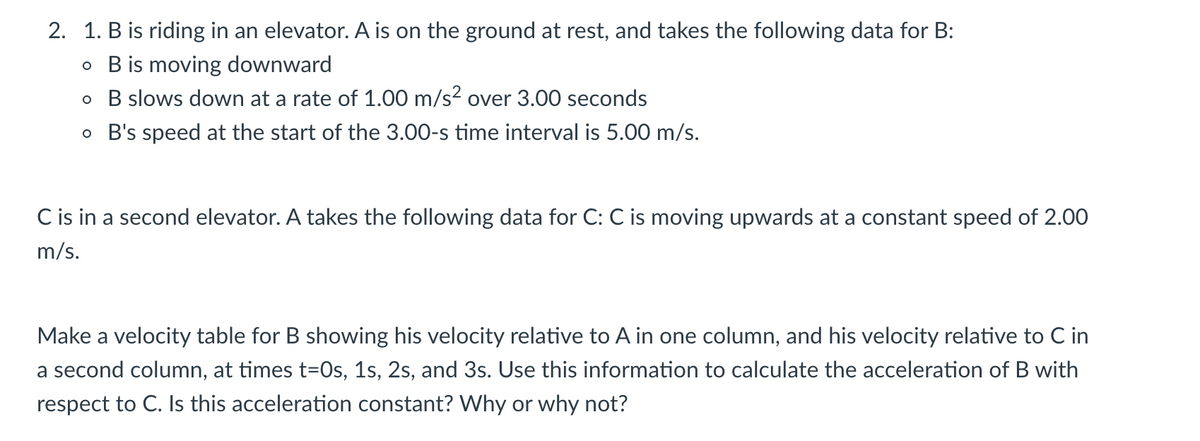2. 1. B is riding in an elevator. A is on the ground at rest, and takes the following data for B: o Bis moving downward o B slows down at a rate of 1.00 m/s² over 3.00 seconds o B's speed at the start of the 3.00-s time interval is 5.00 m/s. C is in a second elevator. A takes the following data for C: C is moving upwards at a constant speed of 2.00 m/s. Make a velocity table for B showing his velocity relative to A in one column, and his velocity relative to C in a second column, at times t=Os, 1s, 2s, and 3s. Use this information to calculate the acceleration of B with respect to C. Is this acceleration constant? Why or why not?
2. 1. B is riding in an elevator. A is on the ground at rest, and takes the following data for B: o Bis moving downward o B slows down at a rate of 1.00 m/s² over 3.00 seconds o B's speed at the start of the 3.00-s time interval is 5.00 m/s. C is in a second elevator. A takes the following data for C: C is moving upwards at a constant speed of 2.00 m/s. Make a velocity table for B showing his velocity relative to A in one column, and his velocity relative to C in a second column, at times t=Os, 1s, 2s, and 3s. Use this information to calculate the acceleration of B with respect to C. Is this acceleration constant? Why or why not?
Physics for Scientists and Engineers: Foundations and Connections
1st Edition
ISBN:9781133939146
Author:Katz, Debora M.
Publisher:Katz, Debora M.
Chapter2: One Dimensional Motion
Section: Chapter Questions
Problem 20PQ
Related questions
Question
how do i solve this problem

Transcribed Image Text:2. 1. B is riding in an elevator. A is on the ground at rest, and takes the following data for B:
o B is moving downward
o B slows down at a rate of 1.00 m/s2 over 3.00 seconds
o B's speed at the start of the 3.00-s time interval is 5.00 m/s.
C is in a second elevator. A takes the following data for C: C is moving upwards at a constant speed of 2.00
m/s.
Make a velocity table for B showing his velocity relative to A in one column, and his velocity relative to C in
a second column, at times t=0s, 1s, 2s, and 3s. Use this information to calculate the acceleration of B with
respect to C. Is this acceleration constant? Why or why not?
Expert Solution
This question has been solved!
Explore an expertly crafted, step-by-step solution for a thorough understanding of key concepts.
This is a popular solution!
Trending now
This is a popular solution!
Step by step
Solved in 3 steps with 3 images

Knowledge Booster
Learn more about
Need a deep-dive on the concept behind this application? Look no further. Learn more about this topic, physics and related others by exploring similar questions and additional content below.Recommended textbooks for you

Physics for Scientists and Engineers: Foundations…
Physics
ISBN:
9781133939146
Author:
Katz, Debora M.
Publisher:
Cengage Learning

Physics for Scientists and Engineers, Technology …
Physics
ISBN:
9781305116399
Author:
Raymond A. Serway, John W. Jewett
Publisher:
Cengage Learning

College Physics
Physics
ISBN:
9781285737027
Author:
Raymond A. Serway, Chris Vuille
Publisher:
Cengage Learning

Physics for Scientists and Engineers: Foundations…
Physics
ISBN:
9781133939146
Author:
Katz, Debora M.
Publisher:
Cengage Learning

Physics for Scientists and Engineers, Technology …
Physics
ISBN:
9781305116399
Author:
Raymond A. Serway, John W. Jewett
Publisher:
Cengage Learning

College Physics
Physics
ISBN:
9781285737027
Author:
Raymond A. Serway, Chris Vuille
Publisher:
Cengage Learning

Principles of Physics: A Calculus-Based Text
Physics
ISBN:
9781133104261
Author:
Raymond A. Serway, John W. Jewett
Publisher:
Cengage Learning

Glencoe Physics: Principles and Problems, Student…
Physics
ISBN:
9780078807213
Author:
Paul W. Zitzewitz
Publisher:
Glencoe/McGraw-Hill